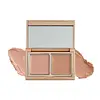What's inside
What's inside
 Key Ingredients
Key Ingredients

 Benefits
Benefits

 Concerns
Concerns

 Ingredients Side-by-side
Ingredients Side-by-side

Hydrogenated Polydecene
EmollientIsononyl Isononanoate
EmollientIsocetyl Stearoyl Stearate
EmollientBis-Diglyceryl Polyacyladipate-2
EmollientMicrocrystalline Wax
Emulsion StabilisingMica
Cosmetic ColorantSilica
AbrasiveVinyl Dimethicone/Methicone Silsesquioxane Crosspolymer
Copernicia Cerifera Wax
Synthetic Wax
AbrasiveVitis Vinifera Seed Oil
EmollientTocopheryl Acetate
AntioxidantAluminum Hydroxide
EmollientLauroyl Lysine
Skin ConditioningBHT
AntioxidantCI 77891
Cosmetic ColorantIron Oxides
CI 42090
Cosmetic ColorantCI 19140
Cosmetic ColorantEthylhexyl Palmitate
EmollientRicinus Communis Seed Oil
MaskingTriethylhexanoin
MaskingPolymethyl Methacrylate
Methyl Methacrylate Crosspolymer
Tocopherol
AntioxidantCI 77491
Cosmetic ColorantCI 15985
Cosmetic ColorantHydrogenated Polydecene, Isononyl Isononanoate, Isocetyl Stearoyl Stearate, Bis-Diglyceryl Polyacyladipate-2, Microcrystalline Wax, Mica, Silica, Vinyl Dimethicone/Methicone Silsesquioxane Crosspolymer, Copernicia Cerifera Wax, Synthetic Wax, Vitis Vinifera Seed Oil, Tocopheryl Acetate, Aluminum Hydroxide, Lauroyl Lysine, BHT, CI 77891, Iron Oxides, CI 42090, CI 19140, Ethylhexyl Palmitate, Ricinus Communis Seed Oil, Triethylhexanoin, Polymethyl Methacrylate, Methyl Methacrylate Crosspolymer, Tocopherol, CI 77491, CI 15985
Polyglyceryl-2 Triisostearate
EmulsifyingDiisostearyl Malate
EmollientPolybutene
Triethylhexanoin
MaskingPentaerythrityl Tetraisostearate
EmollientHydrogenated Microcrystalline Cera
Mica
Cosmetic ColorantSilica
AbrasiveIsononyl Isononanoate
EmollientBis-Diglyceryl Polyacyladipate-2
EmollientCopernicia Cerifera Cera
EmollientWater
Skin ConditioningCaprylyl Glycol
EmollientHydroxyacetophenone
AntioxidantTocopheryl Acetate
AntioxidantCI 77891
Cosmetic ColorantCI 77491
Cosmetic ColorantCI 77492
Cosmetic ColorantCI 19140
Cosmetic ColorantCI 42090
Cosmetic ColorantCI 77499
Cosmetic ColorantPolyglyceryl-2 Triisostearate, Diisostearyl Malate, Polybutene, Triethylhexanoin, Pentaerythrityl Tetraisostearate, Hydrogenated Microcrystalline Cera, Mica, Silica, Isononyl Isononanoate, Bis-Diglyceryl Polyacyladipate-2, Copernicia Cerifera Cera, Water, Caprylyl Glycol, Hydroxyacetophenone, Tocopheryl Acetate, CI 77891, CI 77491, CI 77492, CI 19140, CI 42090, CI 77499
Ingredients Explained
These ingredients are found in both products.
Ingredients higher up in an ingredient list are typically present in a larger amount.
This ingredient is lipid-based synthetic skin-conditioning agent derived from adipic acid and a mixture of fatty acids. It is often called a lanolin substitute.
As an emollient, it helps soften and hydrate the skin. Emollients create a barrier on the skin to trap moisture in.
Due to its fatty acid base, it may not be Malassezia folliculitis safe.
Learn more about Bis-Diglyceryl Polyacyladipate-2CI 19140 is also known as Tartrazine. Tartrazine is a synthetic dye used in cosmetics, foods, and medicine to add a yellow color.
Tartrazine is created from petroleum and is water-soluble.
Some people may experience allergies from this dye, especially asthmatics and those with an aspirin intolerance.
Learn more about CI 19140Ci 42090 is a synthetic dye created from petroleum. It is used to give a bright blue color to cosmetics, medicine, and food.
Ci 77491 is also hydrated iron III oxide. It's sole purpose is to give a red/pink hue to products.
Iron III oxides are classified as inorganic chemicals for coloring.
Synthetically created Ci 77491 is considered safer than those naturally found. This is because the synthetically created version may contain less impurities. Iron oxides are generally non-toxic and non-allergenic.
Learn more about CI 77491Ci 77891 is a white pigment from Titanium dioxide. It is naturally found in minerals such as rutile and ilmenite.
It's main function is to add a white color to cosmetics. It can also be mixed with other colors to create different shades.
Ci 77891 is commonly found in sunscreens due to its ability to block UV rays.
Learn more about CI 77891Isononyl Isononanoate is a synthetic skin-conditioner and texture enhancer. It is created from nonanoic acid, a fatty acid found in cocoa and lavender oil.
As an emollient, Isononyl Isononanoate helps keep your skin soft and smooth. This is because emollients create a barrier on the skin to trap moisture in.
Isononyl Isononanoate helps give products a velvet feel and improves spreadability.
Learn more about Isononyl IsononanoateMica is a naturally occurring mineral used to add shimmer and color in cosmetics. It can also help improve the texture of a product or give it an opaque, white/silver color.
Serecite is the name for very fine but ragged grains of mica.
This ingredient is often coated with metal oxides like titanium dioxide. Trace amounts of heavy metals may be found in mica, but these metals are not harmful in our personal products.
Mica has been used since prehistoric times throughout the world. Ancient Egyptian, Indian, Greek, Roman, Aztec, and Chinese civilizations have used mica.
Learn more about MicaSilica, also known as silicon dioxide, is a naturally occurring mineral. It is used as a fine, spherical, and porous powder in cosmetics.
Though it has exfoliant properties, the function of silica varies depending on the product.
The unique structure of silica enhances the spreadability and adds smoothness, making it a great texture enhancer.
It is also used as an active carrier, emulsifier, and mattifier due to its ability to absorb excess oil.
In some products, tiny microneedles called spicules are made from silica or hydrolyzed sponge. When you rub them in, they lightly polish away dead skin layers and enhance the penetration of active ingredients.
Learn more about SilicaTocopheryl Acetate is AKA Vitamin E. It is an antioxidant and protects your skin from free radicals. Free radicals damage the skin by breaking down collagen.
One study found using Tocopheryl Acetate with Vitamin C decreased the number of sunburned cells.
Tocopheryl Acetate is commonly found in both skincare and dietary supplements.
Learn more about Tocopheryl AcetateTriethylhexanoin is created from glycerin and 2-ethylhexanoic acid. It is a solvent and emollient.
As a solvent, Triethylhexanoin helps dissolve ingredients to stable bases or help evenly distribute ingredients throughout the product.
It is also an emollient and helps condition the skin.
Learn more about Triethylhexanoin